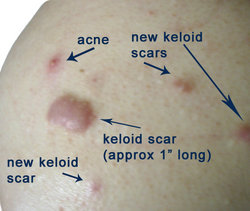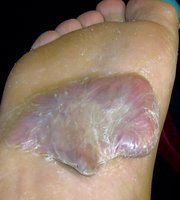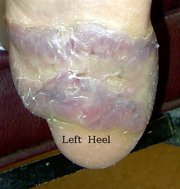Keloids
A keloid scar is a special kind of scar. Keloids are firm, rubbery lesions, and may be reddish or dark in color, or they may be shiny, hard pink-dome shaped lumps. They can result from injury to the skin or may form spontaneously. They often grow, and although they are harmless, non-contagious and usually non-painful, they can be a cosmetic problem. more...
Occurrence
Keloids expand in clawlike growths into normal skin. They have the annoying capability to hurt with a needle-like jabbing pain or to itch uncontrollably without warning. Although these are temporary sensations that come and go, they can be extremely vexing for the victim.
If the keloid becomes infected, it may ulcerate. The only treatment is then to remove the scar completely. Unfortunately, the probability that the resulting surgery scar will become a keloid is high.
Keloids form within scar tissue. Wound collagen, used in wound repair, tends to overgrow the area, sometimes producing a lump many times the size of the original scar. Although they usually occur at the site of an injury, keloids can arise spontaneously. They can occur at the site of a piercing and have been found on the earlobes, eyebrows, chest and other sites of piercings. They can occur as a result of severe acne or chickenpox scarring. They may also be caused by infection at a wound site, repeated trauma to an area, excessive skin tension during wound closure or a foreign body in a wound. They do not go away on their own, and tend to recur after excision. They affect both sexes equally although the incidence in young female patients has been reported to be higher than in young males, probably reflecting the greater frequency of earlobe piercing among women. There is a fifteen times higher frequency of occurrence in people of color. Black skin is most likely to develop keloids.
History in medicine
Keloids were described by Egyptian surgeons about 1700 BCE. Baron Jean Louis Alibert (1768-1837) identified the keloid as an entity in 1806. He called them cancroide. Later he changed the name to cheloide to avoid the connotation of cancer. The word is derived from the Greek chele, meaning crab's claw, and the suffix -oid, meaning like. His clinic at the Hospital St.Louis was for many years the world’s centre for dermatology.
Intentional keloids
The Olmec of Mexico in pre-Columbian times used keloid scarification as a means of decoration. In the modern era, women of the Nubia-Kush in the Sudan are intentionally scarified with facial keloids as a means of decoration. The Nuer and Nuba use lip plugs, keloid tattoos along the forehead, keloid tattoos along the chin and above the lip, and cornrows. As a part of ritual, the people of Papua New Guinea, cut their skin and insert clay or ash into the wounds so as to develop permanent bumps (known as keloids or weals). This painful ritual makes them well respected members of their tribe who are honored for their courage and endurance.
Locations of Keloids
Keloids commonly occur on the shoulders, chest, arms and upper back even when there has been no apparent injury. These are usually the result of pimples, insect bites, scratching, or any other skin trauma.
Read more at Wikipedia.org




